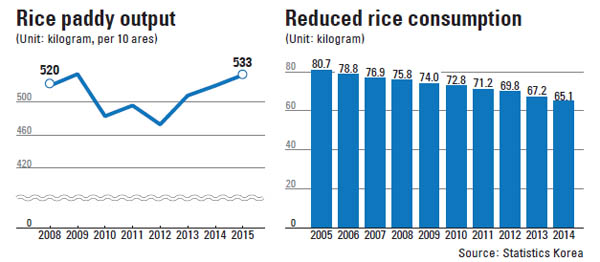Rice farmers worry glut will force down prices

Data from Statistics Korea showed this year’s rice output is forecast to total 4.25 million tons, growing 0.4 percent, or about 17,000 tons, more than last year. The increase is nearly 7.5 percent higher than the average production.
“Last year, there was little damage by major insect pests, diseases and typhoons,” Park Sang-yeong, a Statistics Korea official, said on Wednesday at a briefing in the Sejong Government Complex. Production per 10 ares - an internationally-used gauge - is expected to reach 533 kilograms (1,175 pounds), expanding 2.5 percent from the previous year. It will be the second-largest crop ever, officials said, after 2009.
The record yield is occurring despite Korea losing paddy fields. The total area for rice farming has gradually shrunk over the past years, from 892,000 hectares (2.2 million acres) in 2010 to 816 hectares in 2014. This year it was 799,000 hectares, a drop of 2 percent from last year.
A primary reason for the reduction in paddy fields is the expansion of other interests, such as construction and farming of other agricultural products.
The consumption of rice, however, is also declining. The total amount of rice consumed by an average Korean for an entire year has fallen to 65.1 tons in 2014, from 80.7 tons in 2005.
“Koreans’ appetite has changed into a Western way, preferring meat and bread or skipping breakfast,” an Agriculture Ministry official said. “The new trend in meals is contracting the consumption of rice.”
Despite rising speculation of a rice glut, the government will not raise the amount of this year’s reserved rice, another Agriculture Ministry official said. Rather, it will cut about 70,000 tons for reserved rice from last year to 124,000 tons for this year.
“We set up the amount of reserved rice based on the international standard, allocating 17 percent of consumption,” the official said. “Even if we want to raise it, we can’t do that due to shrinking consumption.”
Currently, an 80-kilogram pack of rice costs 170,000 won ($150) in Korea, below the government target of 188,000 won. Although the government pays 85 percent of the gap between the target and market price to rice farmers, they say the target price should be raised.
Farmers hope the government will purchase more from them as reserved rice, as the government pays more.
“Although farmers receive subsidies from the government if the rice market is in a glut, the subsidies are about 80 percent of market prices,” an official from the South Jeolla Provincial Office in Muan County, a key rice-producing region, said. “Some activists claim an increasing amount of imported rice is triggering a surplus.”
BY KIM HEE-JIN [kim.heejin@joongang.co.kr]










with the Korea JoongAng Daily
To write comments, please log in to one of the accounts.
Standards Board Policy (0/250자)